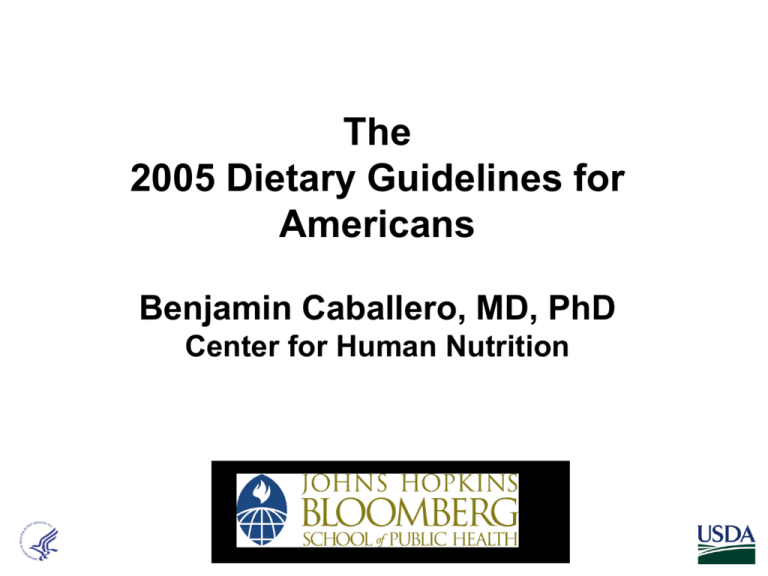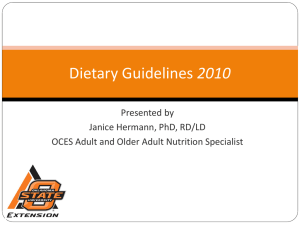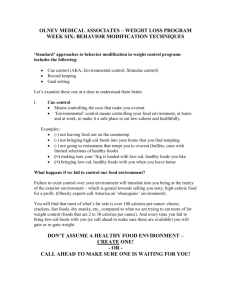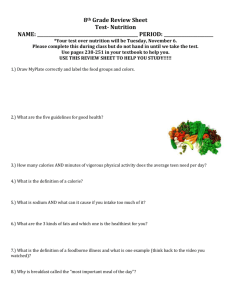Rebuilding the Food Guide Pyramid
advertisement

The 2005 Dietary Guidelines for Americans Benjamin Caballero, MD, PhD Center for Human Nutrition History of Dietary Guidelines • 1977 Dietary Goals for the U.S. (Senate) • 1979 Healthy People Surgeon General’s Report (HHS) • 1980 First Edition of Dietary Guidelines (HHS and USDA) 1980 1985 1995 1990 2000 Dietary Guidelines For Americans • Science-based advice for ages 2+ (gold standard) – Promote health – Prevent chronic disease • Federal nutrition policy/programs • Vehicle to speak with one voice • Jointly developed by HHS/USDA What the Guidelines Do • Provide dietary advice to consumers • Set policy for food assistance programs (e.g., school lunches, elderly nutrition) • Establish overarching goals for National health objectives Nutrition monitoring Nutrition research • Set framework for standards in Food labeling/ fortification Food product development Legislated Mandate for the DGA National Nutrition Monitoring and Related Research Act of 1990 Dietary guidelines must be issued every 5 years Dietary guidance issued by the Federal government for the general public is to be reviewed by the Secretaries of Agriculture, and Health and Human Services. (Departments alternate the lead role.) Systematic Review of Scientific Literature • Identification of research questions • Questions were prioritized by: – Publication/availability of recent systematic reviews by an authoritative source (e.g. IOM, CDC, NIH) – Preliminary literature search to determine if there were enough data (from peer-reviewed sources) to examine the research question • Iterative process Systematic Review of Scientific Literature • All literature examined was peer-reviewed • Human studies were primary focus • Committee assessed study quality and the strength of the evidence • Priority was given to: – trials with well-accepted, clinically relevant outcomes (e.g., incidence of cancer and myocardial infarction) and well-accepted risk factors (e.g., systolic blood pressure, low-density lipoprotein cholesterol, and weight) – longitudinal, cohort studies Opportunities for Public Comments • Over 400 public comments submitted to the Committee • Written comments were accepted throughout the Committee’s deliberations • Oral presentations were made at the January 2004 meeting Content of Science Base • Aiming to Meet Nutrient Intake Recommendations • Energy • Discretionary Calories • Fats • Carbohydrates • Selected Food Groups • Fluid and Electrolytes • Ethanol • Food Safety Key Scientific Recommendations 1. Consume a variety of foods within and among the basic food groups while staying within energy needs 2. Control calorie intake to manage body weight 3. Be physically active every day 4. Increase daily intake of fruits and vegetables, whole grains, and reduced-fat milk and milk products 5. Choose fats wisely for good health 6. Choose carbohydrates wisely for good health 7. Choose and prepare foods with little salt 8. If you drink alcoholic beverages, do so in moderation 9. Keep food safe to eat Nutrient Adequacy Consume a variety of foods within and among the basic food groups, while staying within energy needs. Basic food groups: – – – – – Fruits Vegetables Grains Milk, yogurt and cheese Meat, poultry, fish, dry beans, eggs, and nuts Nutrient Adequacy Nutrient Density • Nutrient-dense foods are those that provide substantial amounts of vitamins and minerals in relatively few calories. Foods of low nutrient density are those that supply calories but little or no amounts of vitamins and minerals. • The greater the consumption of foods or beverages that are low in nutrient density, the more difficult it is to consume enough nutrients without gaining weight, especially for sedentary individuals. • The consumption of added sugars, solid fats, and alcohol provides calories while providing little, if any, essential nutrients. Nutrient Adequacy Nutrient Intake • Adults do not consume enough vitamins A, C, and E; calcium; magnesium; potassium; and fiber. • Children do not consume enough vitamin E, calcium, magnesium, potassium, and fiber. • At the same time, in general, Americans consume too many calories and too much saturated and trans fat, cholesterol, added sugars, and salt. Nutrient Adequacy Special Groups Iron: For adolescent females and women of childbearing age Folic Acid: For women capable of becoming pregnant and in the first trimester of pregnancy Vitamin B12: For those over age 50 Vitamin D: For the elderly, persons with dark skin, and persons exposed to insufficient UVB radiation Energy Balance Discretionary calories: = Total estimated daily energy requirement minus essential calories. To make discretionary calories available or to increase their amount, individuals need to – increase their physical activity AND/OR – consume nutrient-rich foods that are relatively low in energy density. Discretionary calories 2500 Discretionary 2000 EER 1500 1000 Essential 500 0 A B Energy Balance Control calorie intake to manage body weight • Most Americans need to reduce the calories they consume. • For weight control, calories do count—not proportions of carbohydrate, fat, and protein. • The healthiest way to reduce calorie intake is to reduce intake of added sugars, solid fat, and alcohol—they all provide calories, but they do not provide essential nutrients. • Controlling portion sizes helps limit calorie intake, especially when eating energy-dense foods. • For most people, a reduction of 50 to 100 calories per day will prevent weight gain. Physical Activity and Health Be physically active every day Adults: • Thirty minutes of at least moderate physical activity on most days provide important health benefits and reduces the risk of chronic disease. More than 30 minutes of moderate to vigorous physical activity on most days provide even more health benefits. • Participating in up to 60 minutes of moderate to vigorous physical activity on most days is recommended to prevent unhealthy weight gain. • After losing weight, adults who perform 60 to 90 minutes of moderate physical activity daily are more successful at maintaining their reduced weight than those who rely only on limiting calorie intake. Physical Activity and Health Be physically active every day Children and Adolescents: • At least 60 minutes of moderate to vigorous physical activity on most days to maintain good health and fitness and for healthy weight during growth. Increasing physical activity can lower the BMI of overweight children • During leisure time, it is advisable for all individuals to limit sedentary behaviors, such as television watching and video viewing, and replace them with activities that require more movement. Physical Activity Additional Health Benefits: • Exercise that loads the skeleton has potential to reduce the risk of osteoporosis. • Resistance training (8 to 10 exercises twice or more per week) increases muscular strength and endurance and maintains or increases lean body weight. Fats and Fatty Acids Choose fats wisely for good health. Total fat: 20% and 35% of energy for adults Intakes as low as possible of: – Saturated fats: Less than 10% of calories – Trans fats: About 1% of calories or less – Cholesterol: Less than 300 mg of cholesterol per day Fatty Acids Omega-3 fatty acids • Consuming two servings of fish per week (approximately 8 ounces total) may reduce the risks from cardiovascular disease, especially mortality from coronary heart disease. • Other sources of EPA and DHA may provide similar benefits; however, more research is needed. NOTE: Caution for pregnant or lactating women and children to avoid fish with high mercury content. Carbohydrates Choose carbohydrates wisely for good health. Total carbohydrates: Intake 45% to 65% of energy Dietary Fiber: Intake 14 grams per 1000 calories. Added Sugars: Reducing intake of added sugars (especially sugar-sweetened beverages) can lower calorie intake, and may be helpful in achieving recommended nutrient intakes and weight control. Dental caries: Reducing frequency of consuming sugars and starches and optimizing oral hygiene practices is advised Glycemic index/load: Few advantages in using these for dietary guidance Selected Food Groups Increase daily intakes of fruits and vegetables, whole grains, and reduced-fat milk and milk products. Fruits and Vegetables: At 2000 kcal/day, 9 servings (4 ½ cups) Whole Grains: At least three servings (3 ounces) per day Milk: At 1600 kcal/day or more, 3 cups of non-fat or low-fat milk or the equivalent Sodium and Potassium Choose and prepare foods with little salt. • • • • Nearly all Americans consume substantially more salt than they need. The general goal for adults is to consume less than 2,300 mg of sodium per day. Many persons will benefit from reducing salt intake even more. At the same time, individuals are encouraged to increase their consumption of foods rich in potassium. Potassium lowers blood pressure and blunts the effects of salt on blood pressure. Increasing potassium to at least 4,700 mg daily is advised. Alcohol If you drink alcoholic beverages, do so in moderation. • • • • Moderation is up to one drink per day for women and up to two drinks per day for men. One drink is defined as 12 ounces of regular beer, 5 ounces of wine (12 percent alcohol), or 1.5 ounces of 80-proof distilled spirits. Drinking alcoholic beverages should be avoided before or when driving, or whenever it puts anyone at risk. Studies suggest adverse effects even at moderate alcohol consumption levels in specific individuals and situations. Food Safety Keep food safe to eat. • Behaviors in the home most likely to prevent microbial foodborne illnesses: Clean, Separate, Cook, Chill – Cleaning hands, contact surfaces, and fruits and vegetables (but not meat and poultry, which should not be washed) – Separating raw, cooked, and ready-to-eat foods while shopping, preparing, or storing. – Cooking foods to a safe temperature. – Chilling (refrigerating) perishable foods promptly. Food Safety • An important protective measure against foodborne illness is avoiding higher-risk foods. • In the case of listeriosis, high-risk groups such as the very young, pregnant women, the elderly and those who are immunocompromised, should avoid higher-risk foods (e.g. frankfurters and deli meats which have not been heated to a safe temperature). % change in current intake needed to meet the 2005 DG - Main food groups % change in current intake needed to meet the 2005 DG - Subgroups, solid fats and added sugars www.health.gov/dietaryguidelines www.cnpp.usda.gov/DG2005







